We’re on our own again: Vinny and Aileen left a few days ago and while we’re still in Death Valley, our break has come to an end.
It’s over two years since we left the UK and for most of that time my sense of missing people has been low key and manageable. In the aftermath of a wonderful two weeks with Vinny and Aileen, it has sharpened into a keen sensation: I feel somewhat flat but also a real sense of loss. For me, it’s one of the realities of living in the States and one of the consequences of the choice we have made.
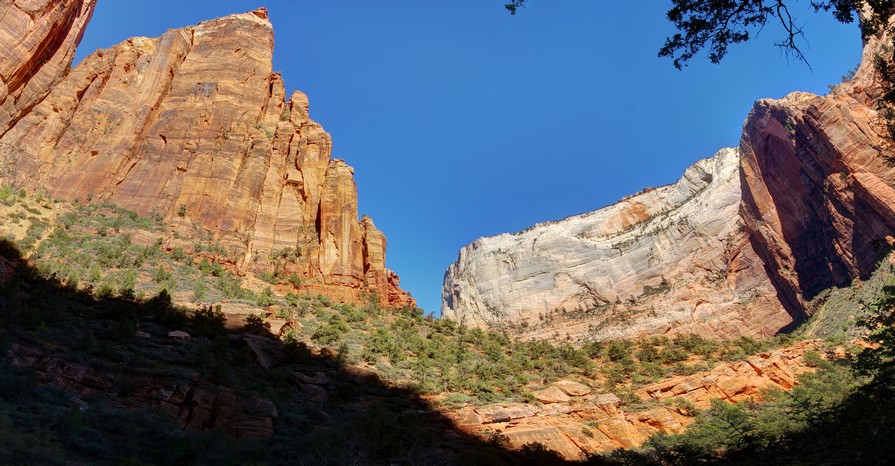 We drive into Zion National Park, Utah, a day ahead of our visitors and engage in a final flurry of work. By mid-afternoon we are done and so treat ourselves to a couple of hours on the bikes. The road out to the Temple of Sinawava is restricted to the park’s shuttle buses as well as bicycles making the ride a pleasure. The way out has some elevation gain and it’s a bit of a challenge for me but I’m distracted by my surroundings. In the late afternoon sun, the red soaring walls of Zion Canyon seem to almost glow, infusing the light with a hint of gold. The Virgin River wends its way amidst stands of vividly green Cottonwoods and the ever narrowing ceiling of sky is a deep pure blue. We can’t remember ever riding in a more spectacular setting.
We drive into Zion National Park, Utah, a day ahead of our visitors and engage in a final flurry of work. By mid-afternoon we are done and so treat ourselves to a couple of hours on the bikes. The road out to the Temple of Sinawava is restricted to the park’s shuttle buses as well as bicycles making the ride a pleasure. The way out has some elevation gain and it’s a bit of a challenge for me but I’m distracted by my surroundings. In the late afternoon sun, the red soaring walls of Zion Canyon seem to almost glow, infusing the light with a hint of gold. The Virgin River wends its way amidst stands of vividly green Cottonwoods and the ever narrowing ceiling of sky is a deep pure blue. We can’t remember ever riding in a more spectacular setting.
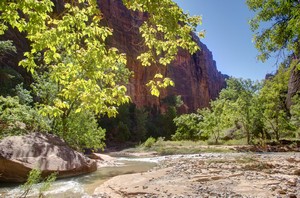 Our visitors arrive in their rented campervan early evening, amidst much excitement: it’s a delight to see them. The next morning we use the shuttle to retrace our ride of the previous afternoon and this time follow the short Riverside Walk to The Narrows, the walls of the canyon gradually closing, the river, in places, reflecting the pink of the rock.
Our visitors arrive in their rented campervan early evening, amidst much excitement: it’s a delight to see them. The next morning we use the shuttle to retrace our ride of the previous afternoon and this time follow the short Riverside Walk to The Narrows, the walls of the canyon gradually closing, the river, in places, reflecting the pink of the rock.
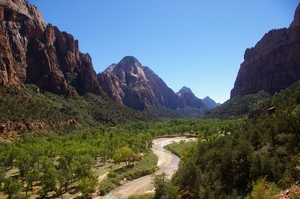 While the setting is stunning the crowds distract a little and it’s with some sense of relief that we move on to the Kayenta trail towards the Emerald Pools. This is much quieter, tracing a path someway up the canyon wall. Below us the water glints in the sun, the Cottonwoods quiver in the breeze and the steep cliffs and peaks fade off into the distance in a bluish haze. At the turn off to the Upper Emerald Pool, Sterling and I carry on up arranging to meet up with Vinny and Aileen at the lodge. The views from the upper trail make the extra mile worth the effort and add to the enjoyment of sitting on the patio with a drink on our return.
While the setting is stunning the crowds distract a little and it’s with some sense of relief that we move on to the Kayenta trail towards the Emerald Pools. This is much quieter, tracing a path someway up the canyon wall. Below us the water glints in the sun, the Cottonwoods quiver in the breeze and the steep cliffs and peaks fade off into the distance in a bluish haze. At the turn off to the Upper Emerald Pool, Sterling and I carry on up arranging to meet up with Vinny and Aileen at the lodge. The views from the upper trail make the extra mile worth the effort and add to the enjoyment of sitting on the patio with a drink on our return.
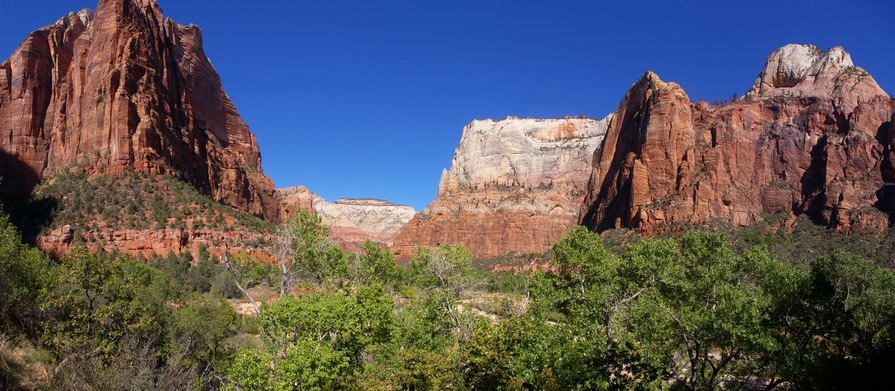 The tunnel on the road heading east out of Zion has a height and width restriction. We must wait till after 8 am for the staff who, a little like human traffic lights, manage one-way movement through this mile long underground section of the road. Our journeys always take longer than expected and after a shop and fuel stop in Kanab we cross into Arizona heading towards the south rim of the Grand Canyon.
The tunnel on the road heading east out of Zion has a height and width restriction. We must wait till after 8 am for the staff who, a little like human traffic lights, manage one-way movement through this mile long underground section of the road. Our journeys always take longer than expected and after a shop and fuel stop in Kanab we cross into Arizona heading towards the south rim of the Grand Canyon.
Time is pressing and we decide to break the journey at Lees Ferry in the Glen Canyon National Recreation Area. The campground is perched on a shelf above the Colorado River and Sterling and I take the short walk down to see the water at closer quarters. Not far from the bank, we’re surprised to see a signboard informing us that we’re entering the Grand Canyon National Park and looking at the map, discover that the Marble Canyon area of the most famous of parks, does indeed stretch a long thin finger this far north.
 The waters are churned and oxygenated here as they pass through a narrowing caused by sediment carried by a tributary and deposited in the main channel. It’s known as a riffle, similar to a rapids but not quite so serious.
The waters are churned and oxygenated here as they pass through a narrowing caused by sediment carried by a tributary and deposited in the main channel. It’s known as a riffle, similar to a rapids but not quite so serious.
 We arrive at the Grand Canyon the next morning, not far ahead of a storm brewing in the north west. We’re just in time to stop at a few overlooks before the cloud rolls in and the rain starts. In spite of previous visits, I’ve never seen the Canyon in this mood, it is truly atmospheric and a wonderful experience, glimpsing the outlines through veils of moving cloud, the details gradually disappearing through sheets of rain.
We arrive at the Grand Canyon the next morning, not far ahead of a storm brewing in the north west. We’re just in time to stop at a few overlooks before the cloud rolls in and the rain starts. In spite of previous visits, I’ve never seen the Canyon in this mood, it is truly atmospheric and a wonderful experience, glimpsing the outlines through veils of moving cloud, the details gradually disappearing through sheets of rain.
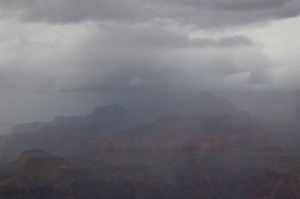 I’m not quite so impressed as we plod through cold puddles in sandaled feet an hour later as we head across the car park towards the general store near Mather campground. The rain is still falling steadily as we book into the campground but as we pull into our sites we’re rewarded by the presence of a large bull elk and three cows: it’s autumn and the rut is just getting underway.
I’m not quite so impressed as we plod through cold puddles in sandaled feet an hour later as we head across the car park towards the general store near Mather campground. The rain is still falling steadily as we book into the campground but as we pull into our sites we’re rewarded by the presence of a large bull elk and three cows: it’s autumn and the rut is just getting underway.
Fortunately the rain stops in time to go out for dinner and while we catch the shuttle to the lodge they have long since stopped running by the time we’re ready to leave. We’re not bothered as we’ve had assurances of the availability of a taxi but the wait time proves unreasonable and we walk the mile or so back, passing another small group of elk who are spending the night not far from the path.
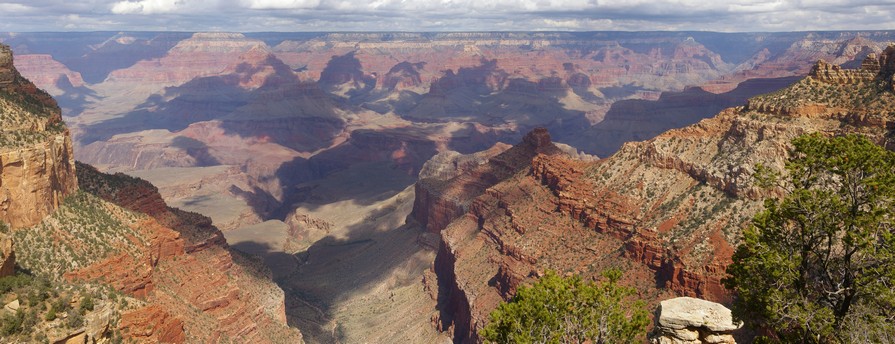 The skies are much clearer the next day as we walk east along the rim to South Kaibab. It’s a paved trail but a few hundred feet past the car parks, it’s surprisingly quiet. The views into the canyon are wonderful, the shadows of fast moving clouds skitting across the depths. Looking down and out into the expanse, the intricacies wrought by erosive powers are hard to comprehend. The enormity, the varying colours, gradients and shadows are mesmerising, a continuing revelation of new details emerging as the eyes attempt to absorb something of this breathtaking phenomenon.
The skies are much clearer the next day as we walk east along the rim to South Kaibab. It’s a paved trail but a few hundred feet past the car parks, it’s surprisingly quiet. The views into the canyon are wonderful, the shadows of fast moving clouds skitting across the depths. Looking down and out into the expanse, the intricacies wrought by erosive powers are hard to comprehend. The enormity, the varying colours, gradients and shadows are mesmerising, a continuing revelation of new details emerging as the eyes attempt to absorb something of this breathtaking phenomenon.
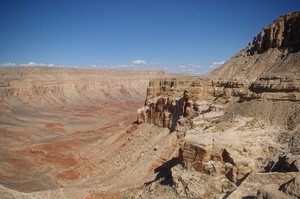 From the Park, we’re heading to one of the tributary canyons for a completely different experience. Havasu Canyon lies just outside the Grand Canyon National Park, within the Havasupai Indian Reservation, and the majority of the tribe live in the village of Supai down in the canyon itself. The only access is by a steep rough trail or by helicopter. We’ve planned an overnight stay in the lodge within the village and mainly due to the walking limitations of Sterling’s Achilles Tendon and Aileen’s knees we have reserved saddle horses to make the eight mile trip both down and up. We arrive at Hualapai Hilltop the night before so that we’re here in good time for an early start.
From the Park, we’re heading to one of the tributary canyons for a completely different experience. Havasu Canyon lies just outside the Grand Canyon National Park, within the Havasupai Indian Reservation, and the majority of the tribe live in the village of Supai down in the canyon itself. The only access is by a steep rough trail or by helicopter. We’ve planned an overnight stay in the lodge within the village and mainly due to the walking limitations of Sterling’s Achilles Tendon and Aileen’s knees we have reserved saddle horses to make the eight mile trip both down and up. We arrive at Hualapai Hilltop the night before so that we’re here in good time for an early start.
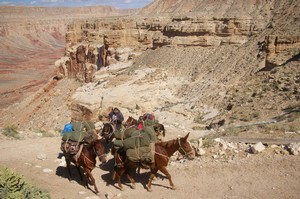
The first hikers start emerging from the trail at about 8 am and pack mule trains follow a couple of hours later. All goods in and out of the canyon come either on the back of a mule or a cargo net swinging on a long cable below the small helicopter. It’s an expensive business. Perhaps the most fascinating aspect of this is the chance to see the only surviving U.S. mail mule train in the country. This is a seriously remote location.
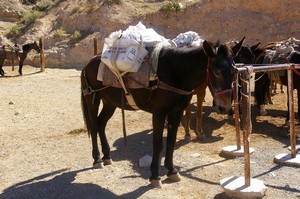
On a trip like this there’s always an adventure. On previous travels with Vinny and Aileen we’ve had the fun of watching our raft-tour guide’s tent floating off down the river as his earlier words “tent pegs are for losers” echo off the surrounding rock, we’ve seen waterspouts approaching the sunset cruise sail boat that we’re on resulting in sailor-like language from the captain as the crew turn the boat around in short order and we’ve met the indubitable Mrs. Doubtfire masquerading as a B&B landlady.
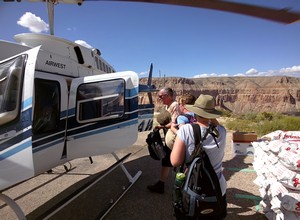 This time around, the adventure stems from horses, or more precisely the singular lack of suitable equine animals. By mid-day no saddle horses have emerged from the canyon to carry us down. Further enquiries reveal that there are none and we’re directed towards the helicopter that flies between the Hilltop and Supai.
This time around, the adventure stems from horses, or more precisely the singular lack of suitable equine animals. By mid-day no saddle horses have emerged from the canyon to carry us down. Further enquiries reveal that there are none and we’re directed towards the helicopter that flies between the Hilltop and Supai.
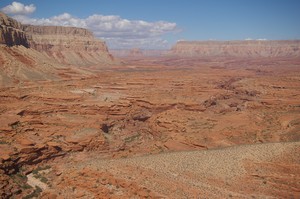 Somewhere in the back of my brain the words “Horses are not guaranteed” floats to the surface and while we’re disappointed in not being able to ride down, the small six person helicopter has an excitement all of its own. Sterling gets the front seat beside the pilot and the rest of us get in the back, two seats facing two, not what you’d call a lot of leg room. The view from the helicopter is stunning, with glimpses out into the wider canyon system and from his vantage position, Sterling gets a few photos and a couple of video snatches during the eight minute flight.
Somewhere in the back of my brain the words “Horses are not guaranteed” floats to the surface and while we’re disappointed in not being able to ride down, the small six person helicopter has an excitement all of its own. Sterling gets the front seat beside the pilot and the rest of us get in the back, two seats facing two, not what you’d call a lot of leg room. The view from the helicopter is stunning, with glimpses out into the wider canyon system and from his vantage position, Sterling gets a few photos and a couple of video snatches during the eight minute flight.
 The village is much as I remember from my first trip here: dirt tracks, no cars, ubiquitous free range dogs, horses and mules in most yards, a plethora of fruit trees and basic housing, set in a natural bowl surrounded by towering red cliff walls. It is a stunning setting although the village of Supai itself is not what you’d call picturesque.
The village is much as I remember from my first trip here: dirt tracks, no cars, ubiquitous free range dogs, horses and mules in most yards, a plethora of fruit trees and basic housing, set in a natural bowl surrounded by towering red cliff walls. It is a stunning setting although the village of Supai itself is not what you’d call picturesque.
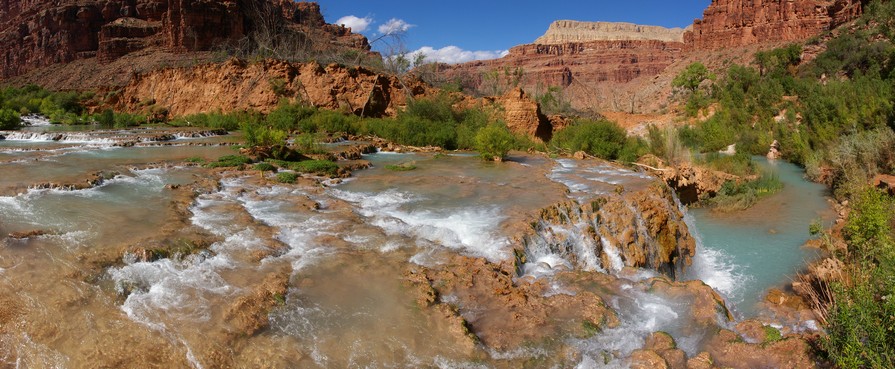 The canyon is famous for it’s stunning waterfalls and the surreal colour of parts of Havasu Creek. In the warm afternoon sun, we set off along the trail, following the canyon on its gradual downward trend. It is every bit as stunning as I remember but our photography cannot do it justice. The water contains high levels of calcium carbonate and magnesium, the former mineral precipitating out to create pools along the course of the creek, the levels of the later determining the intensity of the mesmerising shade of turquoise.
The canyon is famous for it’s stunning waterfalls and the surreal colour of parts of Havasu Creek. In the warm afternoon sun, we set off along the trail, following the canyon on its gradual downward trend. It is every bit as stunning as I remember but our photography cannot do it justice. The water contains high levels of calcium carbonate and magnesium, the former mineral precipitating out to create pools along the course of the creek, the levels of the later determining the intensity of the mesmerising shade of turquoise.
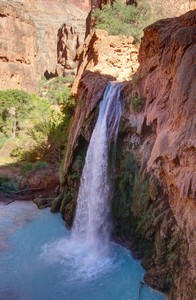 The creek hurtles over the Navajo Falls, cascading down through a series of green-blue pools ahead of falling into the deep plunge-pool at the base of Havasu Falls, from where it continues to the tallest of the Falls, Mooney, at over one hundred and ninety feet. Red sandstone walls, vivid green foliage, turquoise water and a deep blue sky: a combination of colours rarely brought together in natural settings. All we can do is look, trying to imprint something of this beauty within ourselves.
The creek hurtles over the Navajo Falls, cascading down through a series of green-blue pools ahead of falling into the deep plunge-pool at the base of Havasu Falls, from where it continues to the tallest of the Falls, Mooney, at over one hundred and ninety feet. Red sandstone walls, vivid green foliage, turquoise water and a deep blue sky: a combination of colours rarely brought together in natural settings. All we can do is look, trying to imprint something of this beauty within ourselves.
By half eight the next morning we’re ready and waiting for the horses that we’re riding back up to The Hilltop. By nine there’s no sign of them and asking at the frontdesk, we’re told that there’s been a problem and they’re still trying to make arrangements. The adventure anthem starts playing as the small-print sentence “Horses are not guaranteed” floats onto the screen.
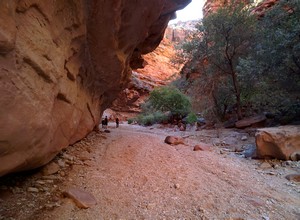 Before long it becomes clear that ‘horses are not guaranteed’ actually means horses are extremely unlikely. We resign ourselves to taking the helicopter again, only to find that it doesn’t fly on Tuesdays. There’s only one other way out: walking. I hiked both ways last time I was here and know it’s a demanding walk: eight miles and two thousand feet of climb, over half of it in the last mile or so. For people with knee and Achilles Tendon problems it seems like a tall order. There’s no other option, so having loaded up with provisions, we set off. We’re joined by Tammy who’s in the same boat as us and chose to go out by horse as she has breathing issues.
Before long it becomes clear that ‘horses are not guaranteed’ actually means horses are extremely unlikely. We resign ourselves to taking the helicopter again, only to find that it doesn’t fly on Tuesdays. There’s only one other way out: walking. I hiked both ways last time I was here and know it’s a demanding walk: eight miles and two thousand feet of climb, over half of it in the last mile or so. For people with knee and Achilles Tendon problems it seems like a tall order. There’s no other option, so having loaded up with provisions, we set off. We’re joined by Tammy who’s in the same boat as us and chose to go out by horse as she has breathing issues.
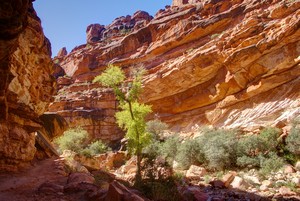 The first seven miles go steadily and the hike is a delight. The path follows the narrow, tightly meandering canyon, an occasional cottonwood along the way that has survived the flash floods that scour this area. Both Sterling and Aileen have taken ibuprofen and at this stage seem fine as does Tammy. All this changes as we begin the serious climb: knees, tendons and lungs are under serious strain on this extremely steep and rough part of the trail. Tammy slows to a ‘fifty steps and a rest’ mode and we cannot just leave her: Vinny and Aileen go on while Sterling and I stay with Tammy. Whatever pain the knees and tendon are causing, it becomes clear that lack of breath is the real danger here and we are seriously concerned about her. A considerable time later and about half way up, Tammy’s friends, who had hiked out earlier in the morning in the belief that she was riding out, come back down to support her and we are able to make slow but steady progress to the top.
The first seven miles go steadily and the hike is a delight. The path follows the narrow, tightly meandering canyon, an occasional cottonwood along the way that has survived the flash floods that scour this area. Both Sterling and Aileen have taken ibuprofen and at this stage seem fine as does Tammy. All this changes as we begin the serious climb: knees, tendons and lungs are under serious strain on this extremely steep and rough part of the trail. Tammy slows to a ‘fifty steps and a rest’ mode and we cannot just leave her: Vinny and Aileen go on while Sterling and I stay with Tammy. Whatever pain the knees and tendon are causing, it becomes clear that lack of breath is the real danger here and we are seriously concerned about her. A considerable time later and about half way up, Tammy’s friends, who had hiked out earlier in the morning in the belief that she was riding out, come back down to support her and we are able to make slow but steady progress to the top.
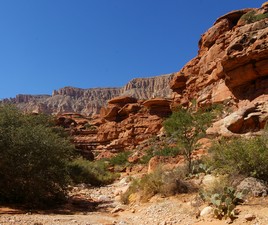
Needs must may be a trite saying but in this case seems completely appropriate. Neither Sterling nor Aileen would have gone down into the canyon had they thought they were going to have to hike out. Yet in spite of the pain, they both make it and most amazingly were fine the next day: Vinny and I are convinced they’ve been stringing us along.
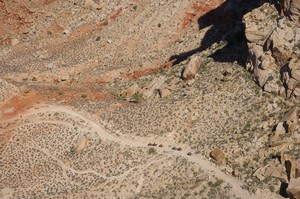 Maybe we should have taken the lack of horses to ride down as a sign. Maybe we should have heeded the “Horses are not guaranteed” small print. Maybe we should have checked that the helicopter was flying the next day. The Havasupai Tribe as a whole accepts no responsibility for visitor safety. When we got to the top there was no-one there to know whether we’d made it. Had Tammy collapsed or Sterling and Aileen been unable to go on, there is no back-up or rescue system. If we’d known it was unlikely that horses were available or that the helicopter didn’t fly every day we would never have gone down. We know our collective limitations and thought we had made arrangements to take account of these.
Maybe we should have taken the lack of horses to ride down as a sign. Maybe we should have heeded the “Horses are not guaranteed” small print. Maybe we should have checked that the helicopter was flying the next day. The Havasupai Tribe as a whole accepts no responsibility for visitor safety. When we got to the top there was no-one there to know whether we’d made it. Had Tammy collapsed or Sterling and Aileen been unable to go on, there is no back-up or rescue system. If we’d known it was unlikely that horses were available or that the helicopter didn’t fly every day we would never have gone down. We know our collective limitations and thought we had made arrangements to take account of these.
We spend the night at Lake Mojave and while Sterling and I catch up with some work the next morning, Vinny and Aileen set off for Hoover Dam, the plan being to meet up in Death Valley later in the day for the last five days of our trip.
 Death Valley, the largest National Park in the lower forty eight, is enormous. Covering an area of five thousand two hundred and nineteen square miles it’s two thirds of the size of Wales or four times the size of Rhode Island.
Death Valley, the largest National Park in the lower forty eight, is enormous. Covering an area of five thousand two hundred and nineteen square miles it’s two thirds of the size of Wales or four times the size of Rhode Island.
The classic headline for the park is as the lowest, hottest place in the western hemisphere and certainly the wide open expanse of Death Valley itself is impressive. The surrounding mountains sweep down the alluvial fans, definition and colour muted through the glimmering heat. The landscape is faded, bleached by the sun, the gentle pastel shades ranging from the white of the salt flats to the greens, yellows and purples of the badlands and the pinks of the higher elevations.
 This is a park of many faces and in dramatic contrast to the main valley, we visit the inactive volcanic cinder crater of Ubehebe. Here, I am driven to distraction by Sterling’s daft pronunciation of the name and needless to say Vinny and Aileen take up the cry. The trail around the crater is a delight, the views down into the crater and out across the surrounding land make the repetition of the crater’s name worthwhile.
This is a park of many faces and in dramatic contrast to the main valley, we visit the inactive volcanic cinder crater of Ubehebe. Here, I am driven to distraction by Sterling’s daft pronunciation of the name and needless to say Vinny and Aileen take up the cry. The trail around the crater is a delight, the views down into the crater and out across the surrounding land make the repetition of the crater’s name worthwhile.
The soaring temperatures and our need for some down time combine to slow our pace and the loungers and chairs get some serious use. The only real downside to the high temperatures is that our fridge struggles to stay sufficiently cold: the thick juicy steaks that Vinny has promised to barbeque prove unusable and to my great disappointment have to be replaced with vegetarian burgers and sausage: what a let down.
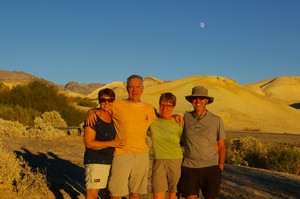 Other than this, the heat is amazing, the hottest day coming on the last of the trip with the thermometer showing 107 degrees F or 42 degrees C. We sit in the shade and even the sun goddess, Aileen, retreats from the direct sun. What’s most amazing is that the heat of the summer has passed, this is autumn here in the valley of death.
Other than this, the heat is amazing, the hottest day coming on the last of the trip with the thermometer showing 107 degrees F or 42 degrees C. We sit in the shade and even the sun goddess, Aileen, retreats from the direct sun. What’s most amazing is that the heat of the summer has passed, this is autumn here in the valley of death.
Our shared time is over and it’s with heavy hearts that we wave them off at six the following morning. It’s been such a delight spending this time with Vinny and Aileen: it’s gone far too quickly and the hole left by their departure is painful.